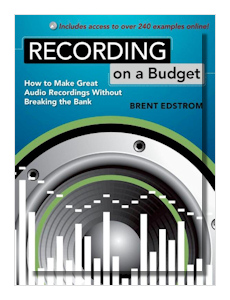
The Internet's Premier Classical Music Source
Related Links
-
Introduction
Acoustics
Ballet
Biographies
Chamber Music
Composers & Composition
Conducting
Criticism & Commentary
Discographies & CD Guides
Fiction
History
Humor
Illustrations & Photos
Instrumental
Lieder
Music Appreciation
Music Education
Music Industry
Music and the Mind
Opera
Orchestration
Reference Works
Scores
Thematic Indices
Theory & Analysis
Vocal Technique
Search Amazon
Recommended Links
Site News
 Book Review
Book Review
Recording on a Budget

How to Make Great Audio Recordings
Without Breaking the Bank
Brent Edstrom
Oxford University Press, USA, 2010 xiv + 250 pp
ISBN-10: 0195390423
ISBN-13: 978-0195390421
Classical Net music lovers who want to take a break from listening and record something of their own could well learn a lot from a new and very informative book from OUP, Recording on a Budget, by Brent Edstrom. Aimed at anyone more widely interested in all aspects of recording from acoustics through equipment, hard- and software, studio setup to mixing and mastering, it claims to be a comprehensive, practical and accessible single volume guide to what's involved in recording and presenting a wide range of musical or spoken events, performances and concerts etc. with the emphasis on affordability.
Those are claims which can easily be substantiated: in the first place, the book is very well-written. Terms are explained, illustrated (there are plenty of tables, diagrams and graphics generally throughout the book) and used in context – this is not a dictionary. Almost every aspect of the recording process which the newcomer or aspiring engineer will need to know is explained lucidly and simply, yet without dilution. The dozen chapters cover setting up a studio, choosing and using computers and a Digital Audio Workstation, the nature of sound, microphones, podcasting, recording, mixing, signal processing – and Active Listening, a chapter which has relevance to us as listeners to music beyond the immediate context of this topic.
As central to the book's value for those interested in recording as the subject matter, which is so comprehensively and clearly covered, is the emphasis on reducing cost. Setting up and running a studio, of course, can be way beyond the reach of many. Edstrom's surveys of approaches and equipment are very successful. They guide those nevertheless determined to work in the field very effectively. It's important that the sacrifices in quality to cut costs are not too great and the author's strategies are many– planning and documenting sessions so as not to waste resources; using inexpensive or free software in addition to and/or instead of the best bespoke packages like Apple's Logic; eliminating (hankerings for!) unnecessary plug-ins and gadgets; learning how the professionals work so as really to maximize use of time, which is money, and so on. There are even Do-It-Yourself examples… the final chapter covers building your own computer and speaker stands with plenty of close-ups of soldering irons and screwdrivers. Yet Recording on a Budget is not duct-tape intensive. Not only is it obvious that Edstrom knows what he's doing (and must have tried most, if not all, of the projects and procedures he describes and advocates), but that he has certain standards and levels of quality going below which in the interests of saving money he will not advise.
The book is chock full of up-to-date resources, further reading suggestions, websites and manufacturers' details etc. There's a companion website, although this doesn't at present contain 'Breaking News', but the audio files referred to in the book, which is a good start. It's true that many of the musical examples which the author gives are not from the world of serious music, but valid and relevant points can still be made. Appendices, notes and an adequate index round out what it sure to more than meet the needs of anyone interested in making their own recordings. Production levels for the book are as high as its price is reasonable.
Copyright © 2011 by Mark Sealey.



















